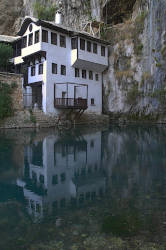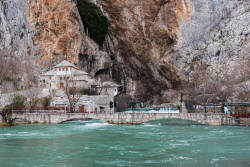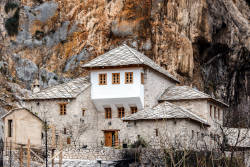Izvor Buna
Vrelo Bune
Useful Information

| Location: | Near Blagaj, south of Mostar, Herzegovina-Neretva Canton. Mostar-Dubrovnik road, turn off towards Nevesinje. Behind Blagaj at the former trout farm. |
| Open: |
no restrictions. [2020] |
| Fee: |
free. [2020] |
| Classification: |
 Karst Spring Karst Spring
|
| Dimension: | Yavg=43.000 l/s, Ymin=3,000 l/s, Ymax=123,000 l/s. T=8 °C. |
| Photography: | allowed |
| Accessibility: | yes |
| Bibliography: |
William Miller (1898):
Travels and politics in the Near East,
New York : Frederick A. Stokes.
archive.org
|
| Address: | |
| As far as we know this information was accurate when it was published (see years in brackets), but may have changed since then. Please check rates and details directly with the companies in question if you need more recent info. |
|
History
| 1663 | first mention of Tekke in Blagaj. |
| 1851 | first reconstruction of Tekke. |
| 1951 | rock slides caused major damages to the Tekke, restoration by the Institute for Protection of Cultural Monuments of Bosnia and Herzegovina. |
| 1952 | dervishes expelled from the Tekke. |
| 2012 | restoring the authentic look to Tekke. |
Description
Anne Oldham and her daughter Christina describe a trip taken in 1986:
|
[At Mostar] Then we set off for the largest karst spring in Europe, Izvor Buna at Blagaj. From Mostar you take the Dubrovnik road, and turn off towards Nevesinje. Keep straight on past the airfield towards Blagaj, straight through the village, and park beside the trout farm. The cave is a few meters beyond this. You cannot actually enter the cave, a wide rock arch about 4.5 m high, from which the spring resurges, without a boat. It has a flow of 26-46 cubic litres per second, or a 6 m wide rushing river to most of us, and soon sumps a little way into the cave. The engulfment is in the Nevisinjsko Polje, 19.5 m away where the river Zalomska sinks. There is a legend attached to the cave. A dragon used to live there and each year he came forth to capture and devour a local maiden. One year he chose Milica, daughter of the ruler Herceg Stefan. As he was about to carry her off, a local dervish, Sari Saltuk, who was madly in love with her, leapt to her rescue and killed the dragon. Her father was so grateful he allowed the couple to marry and a Tarka or Turkish House was built on the site. The cave entrance which can be seen higher up and 300 m to the right of the spring is the Green Cave where Neolithic and other remains have been found. from: Anne Oldham: Yugoslavia 1986. Published privately by the author. pp 63 illus. With kind permission. |


The main Buna spring is actually a resurgence of a cave river, a huge cavern which is mostly waterfilled. There are numerous side branches of the Buna, some forming impressive gorges, which are dry most of the year. Many of those springs are reactivated only during time of high water level, during snow melt and sometimes after heavy rains. The Buna spring is called the largest karst spring in Europe, with a yield of 43.000 l/s in average. Depending on the season this may change between 3,000 l/s and 123,000 l/s.
The most impressive thing about this spring is probably not its yield, but its unique location. The river emerges from a huge portal at the foot of a 200 m high limestone cliff. The water is dammed only a few meters from the spring, as the water power and the water were used for centuries. The river is surrounded by historic buildings. The building closest to the spring is a former Islamic monastery from the 15th century named Blagaj Tekija (Tekke House). Today it houses the Visitor Center of the spring. It was renovated a few years ago, as the 600 years old building were destroyed more than 100 years ago.
Right below there are four restaurants built along the spring. The restaurant Riblji restoran "Mlinica" is located directly at the monastery, with a terrasse at water level. The restaurant "Vrelo" is only a few meters down the river in the former trout farm. It is quite huge and has terraces on both sides of the river, and the river is flowing through the restaurant. Then there is Restoran "Hladovina" and at last Restoran "Biser". All of them serve the local trout, which is farmed in the abundant water of the spring.
The place has always been popular, but lately it became quite well developed. Once the Balkan War ended, the tourism revived and now there are more than 10,000 visitors per year [2014]. This is the reason why there are now so many restaurants at the location.

A multitude of birds glided ceaselessly over the water or flew in and out of the countless crannies in the limestone cliff, while the fish darted to and fro in the rapid current of the Buna. Nestling under the shadow of the rocks at one side of the cavern, hard by a ruined mosque is a tiny house, the goal of many a pious Moslems footsteps, containing the tombs of a Mohammedan saint and his faithful servant. On the wall above, the scimitar and battleaxe of the holy man still remind the pilgrims of the unbelievers whom he slew, while every evening the custodian religiously places a jug of water and a towel by the coffin for the saints ablution. Every morning, so they told us in awestruck tones, the towel is moist and the jug half empty. To a wooden veranda overhanging the stream a skiff is moored, in which, to the immense delight of our two small companions, I pulled myself inside the mouth of the cavern. Huge stalactites hang from thereof and almost kiss the deep-blue water, and in the distance far under the mountain one hears a noise as of thunder.
No one has ever navigated this subterranean stream, but the local legend tells how one day a shepherd threw his staff into the Zalomska river, which disappears in the earth some thirteen miles away, and how his father, a miller at Blagaj, found it floating in the Buna. Father and son communicated with one another and resolved to profit by this freak of nature. Every day the shepherd slew one of his masters sheep, threw its carcass into the Zalomska, and so despatched it to his father, who fished it out of the Buna a few hours later. At last the owner of the flock became suspicious, set a watch upon his shepherd, and one day caught him in the act of throwing a dead sheep into the stream. That evening the miller saw in the waters of the Buna, instead of the usual sheep, the headless trunk of his son.
High on the rocks above the source of the Buna there stand the majestic ruins of Stephens Castle, or Stjepa-nograd. There, four centuries ago, Duke Stephen Kosaca, from whose ducal title the Hercegovina derived its German name, defied all comers, till his own son made him a captive in his own impregnable stronghold.
William Miller (1898):
Travels and politics in the Near East,
New York : Frederick A. Stokes.
archive.org
Vrelo Bune
- See also
 Search DuckDuckGo for "Izvor Buna"
Search DuckDuckGo for "Izvor Buna" Google Earth Placemark
Google Earth Placemark OpenStreetMap
OpenStreetMap Vrelo Bune - Wikipedia (visited: 15-DEC-2020)
Vrelo Bune - Wikipedia (visited: 15-DEC-2020) Blagaj - Buna River (visited: 15-DEC-2020)
Blagaj - Buna River (visited: 15-DEC-2020) Izvor rijeke Bune: Idealno mjesto za izlet koje će vas opustiti i inspirirati
Izvor rijeke Bune: Idealno mjesto za izlet koje će vas opustiti i inspirirati  (visited: 15-DEC-2020)
(visited: 15-DEC-2020) Vrelo Bune/Buna Spring Geocache (visited: 15-DEC-2020)
Vrelo Bune/Buna Spring Geocache (visited: 15-DEC-2020) Blagaj’s Dervish Monastery - Atlas Obscura (visited: 13-JUL-2025)
Blagaj’s Dervish Monastery - Atlas Obscura (visited: 13-JUL-2025)
 Index
Index Topics
Topics Hierarchical
Hierarchical Countries
Countries Maps
Maps